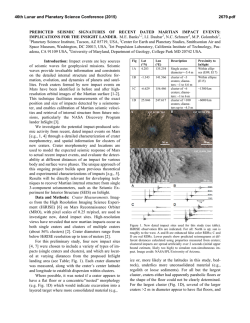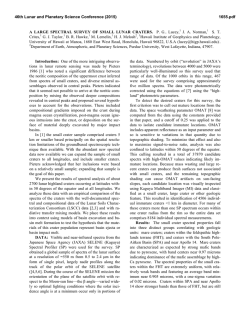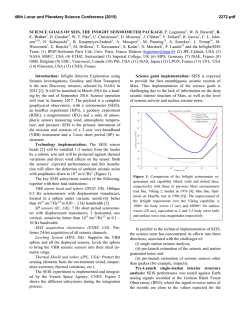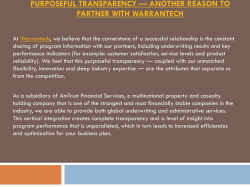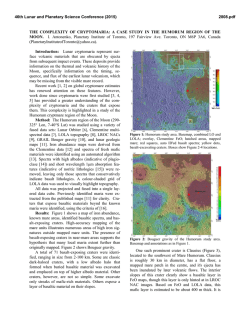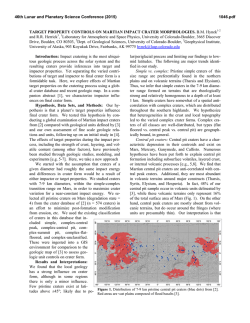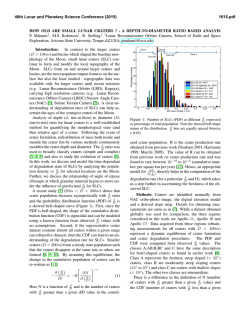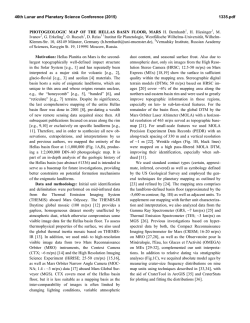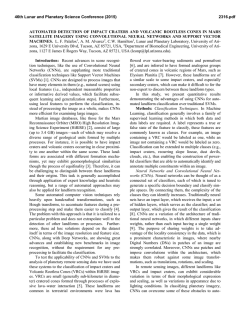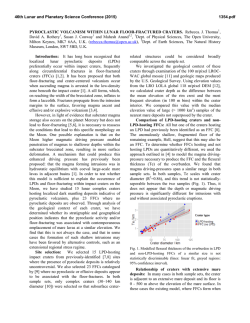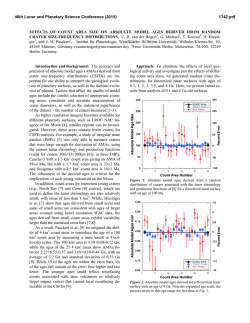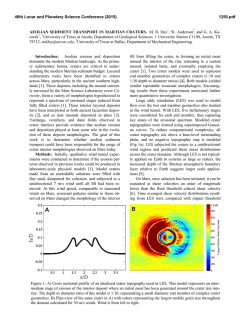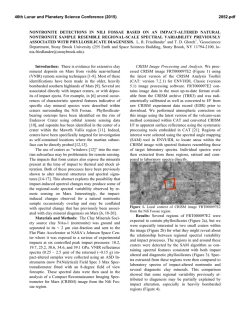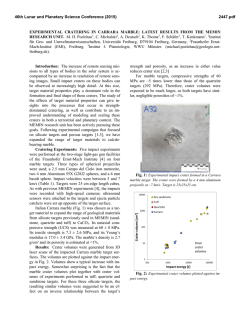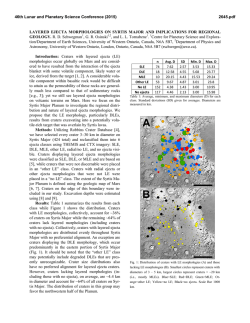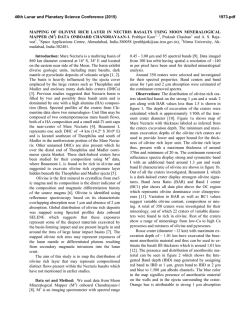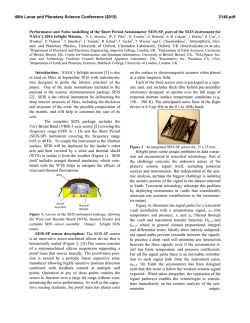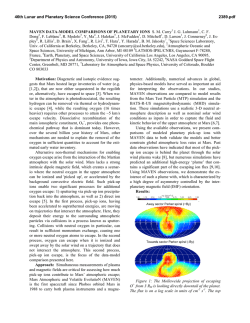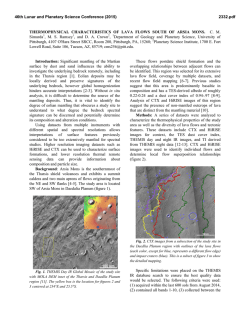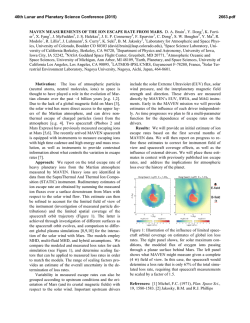
measurement of the current martian cratering size frequency
46th Lunar and Planetary Science Conference (2015) 2468.pdf MEASUREMENT OF THE CURRENT MARTIAN CRATERING SIZE FREQUENCY DISTRIBUTION, PREDICTIONS FOR AND EXPECTED IMPROVEMENTS FROM INSIGHT. I. J. Daubar1, M. P. Golombek1, A. S. McEwen2, S. Byrne2, M. Kreslavsky3, N. C. Schmerr4, M. E. Banks5,6, P. Lognonné7, T. Kawamura7, F. Karakostas7. 1Jet Propulsion Laboratory, California Institute of Technology, Pasadena CA 91109 ([email protected]. gov). 2University of Arizona, Tucson AZ. 3University of California Santa Cruz, Santa Cruz CA. 4University of Maryland, College Park MD. 5Planetary Science Institute, Tucson AZ. 6Smithsonian Air and Space Museum, Washington DC. 7IPGP, Sorbonne Paris Cité, Univ Paris Diderot, France. Introduction: In the last decade, nearly 500 new, dated impact sites have been identified on Mars based on before and after imaging (Fig. 1). The current cratering rate has been calculated using this data set [1, 2]. We will be able to use that measured production function (PF) to predict what the upcoming NASA Discover Program lander InSight [3] will be able to detect. InSight will improve on this measurement in several ways, including eliminating observational biases. of eight for long time periods. Monte-Carlo analysis of the spatial distribution of this data set [2] leads to the conclusion that randomness of the detected population (even within dusty areas) is rejected with great confidence. Dark spots are not uniformly created or detected everywhere in dusty regions (Fig. 1). To compensate for the effect of nonuniform crater detection efficiency the PF needs to be increased by a minimum factor of 1.7 [2]. More realistically, this factor probably varies with diameter since it is likely that smaller craters are preferentially missed over certain dusty terrains, biasing the SFD slope. 90 60 1.E-03 Latitude 30 0 All dated impacts Icy impacts Malin et al. 2006 CTX-CTX -60 -90 0 60 120 East Longitude 180 240 300 Figure 1: 484 new dated impact sites on a map of the TES Dust Cover Index [9]. Also shown are 19 confirmed sites from [6] & the subset constrained by CTX. Current measured cratering rate: Method: New impacts are initially recognized as dark spots in Context Camera (CTX) [4] images that were not present in previous images. The High Resolution Imaging Science Experiment (HiRISE) [5] follows up to confirm an impact origin and measure the craters. We scale the impact size frequency distribution (SFD) to only those areas with repeat coverage and a minimum amount of dust cover, and by a spatial randomness correction. We use an Area-Time Factor (ATF) that is a sum of area covered repeatedly by CTX, multiplied by the time difference between images at each spot [1]. Figure 2 shows the resulting SFD using effective diameters (combined for clusters as in [6]) for 110 impacts with CTX before and after images, scaled to an ATF of 4.68×107 km2 yr. Our measured PF falls below model PFs by Ivanov/Neukum [7] and Hartmann [8] by a factor of ~4 for ~4 m < D < 30 m. If long-term orbital eccentricity variations are taken into account [7], this discrepancy might increase to a factor 360 F(D)=Differential craters / km^3 / year 1.E-04 -30 1.E-05 1.E-06 Malin et al. 2006 CTX-CTX, 2013 (N=44) CTX-CTX, updated (N=110) Hartmann 1 y 1.E-07 1.E-03 1.E-02 1.E-01 Diameter (km) Figure 2: Current SFD for a one-year PF using craters discovered in CTX before and after images [1, 2]. Shaded line is the best fit for craters 4-30 m diameter. Results: The current cratering rate at Mars was measured by [1] to be 1.7×10-6 D≥3.9 m/km2/yr. Recently we updated this measured rate to include newer data; the results are nearly identical: 1.8×10-6 D≥3.9 m/km2/yr [2]. Detected craters are not randomly distributed, even within dusty areas with repeat coverage. The modern CSFD (Fig. 2) is lower for D<50 m than models commonly used to estimate crater retention ages on Mars. If extrapolated to larger sizes, it would be greater than those models. Using this PF to date a 46th Lunar and Planetary Science Conference (2015) given surface would result in model ages that are higher by a factor of ~four if using small diameters, or lower by some factor if extrapolated to larger sizes [e.g., 10]. This surprising near-agreement might yet be an accident if the current impact rate is not typical of geologic time, i.e., we can’t rule out large short-term fluctuations. The published martian isochrons should be used with great caution for small craters. Our current impact rate statistics provide the best empirical isochrons for the youngest surfaces on Mars, but they still include uncertainties of a factor of about four. Spatial distribution: The dark blast zones used for initial detection are interpreted as being formed by disturbance or removal of high-albedo surface dust in the impact blast. Because this is key to the identification of new impact sites, the data set has an obvious spatial bias toward the dustiest areas of Mars (Fig. 1). Even within these areas, all dusty areas do not appear to form dark blast zones equally efficiently [2]. Thus current impacts may be occurring that are not being detected, even in places where CTX has repeat coverage. InSight will address this problem by avoiding such an observational bias toward dusty areas. InSight: The InSight Discovery mission [3] launches in 2016 and will carry a seismometer, Seismic Experiment for Interior Structure (SEIS) [11]. One of the mission’s scientific objectives is to measure the rate of meteorite impacts [3]. Predicted impact detections: Impacts are likely to occur close to the InSight landing site. In fact, several have occurred in the last few years near, and even within, proposed landing ellipses [12, 13] (Figure 3). SEIS will be able to distinguish impact-induced seismic signals from those of small quakes through the analysis of the cutoff frequency [13]. SEIS will detect small impacts nearby and large ones farther away; the minimum detectable crater size increases with increasing distance out to ~3,000 km for the largest craters we are likely to observe. Once the detection capability as a function of distance is better characterized, we will be able to predict the number of impacts that will be detected of a given size, using various production functions (PFs) from [1], [2], [8] and [14]. InSight will test these predictions and provide an independent measure of the current cratering rate at Mars. Different biases: The detection capability of SEIS is independent of a surface covering of high-albedo dust, thus eliminating the bias toward blast-zoneforming areas in the method used by [1, 2]. Nonrandom distributions due to differing dust removal behaviors will also be avoided. Of course, SEIS will have its own observational biases that will need to be accounted for. (1) The capability of size detection with distance, which can be 2468.pdf Figure 3: Locations of new dated impacts (yellow squares) that have occurred near proposed InSight landing ellipses (white; shown before downselection). Basemap is TES DCI [9] (same scale as Fig. 1) over THEMIS Day IR [15]. Lower dust cover to the west is likely contributing to fewer craters being found there. addressed by scaling the production function to appropriate areal extents for different diameters. (2) Target properties and uncertainties in the calibration will initially influence the estimated sizes and distances of impacts. Once several impacts have been detected by SEIS, and located and measured in orbital images, this issue will be addressed by that calibration. (3) Detection capability may be reduced for impactors that break up in the atmosphere creating clusters of craters [12, 13], which comprise about half of the new impacts [1]. The seismic signal from a cluster may be spread out in time, and its waveform will differ from that of a single impact. These issues may complicate cluster impact identification. Given that the proportion of clusters to single-crater impacts is known, however, this bias can also be corrected, given adequate statistics. Conclusions: Measured current and model production function CSFDs will be used to predict the number of impacts InSight will detect as a function of crater size. InSight will test these predictions and clarify some of the uncertainties in previously used CSFD measurement methods and models. References: [1] Daubar et al. (2013) Icarus 225, 506-516. [2] Daubar et al. (2014) 8th Mars Conf., Abs. 1007. [3] Banerdt et al. (2013) LPSC, Abs. 1915. [4] Malin et al. (2007) JGR 112, 5. [5] McEwen et al. (2007) JGR 112, 5. [6] Malin et al. (2006) Science 314, 1573-1577. [7] Ivanov (2001) SSR 96, 87-104. [8] Hartmann (2005) Icarus 174, 294-320. [9] Ruff and Christensen (2002) JGR 107, 5127. [10] Landis et al. (2014) LPSC, Abs. 2661. [11] Lognonné et al. (2000) Planet. Space Sci. 48, 1289-1302. [12] Schmerr et al. (2014) GSA Abs. 259-12. [13] Banks et al., (2015) LPSC. [14] Williams et al. (2014) Icarus 235, 23-36. [15] Edwards et al. (2011) JGR 116, E10008.
© Copyright 2026
